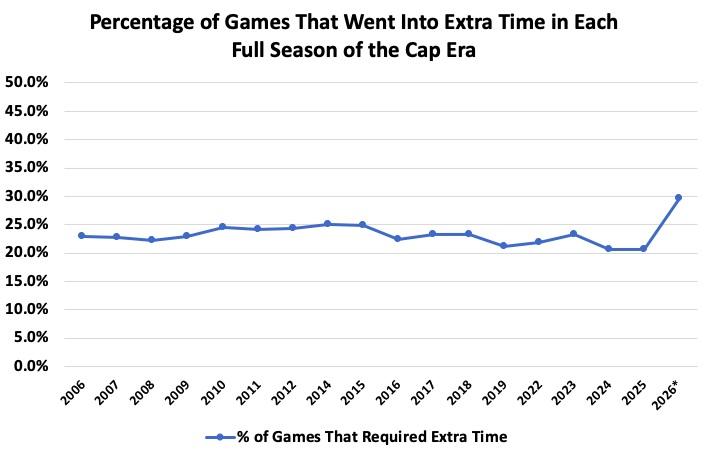The Increase in Overtime Games in the 2025-2026 NHL Season
Yesterday on November 4th, 2025, five of the 10 NHL games played went into extra time, with two of those five ending in overtime and three going all the way to the shootout. Having half of all games go into overtime on a busy day of hockey is certainly rare, but could be written off as a coincidence. However, this doesn’t seem to be a coincidence for the 2025-2026 NHL season, but rather a new norm that is forming.
As seen by the graph below, 29.6% of all games so far this season have gone into overtime, a staggering increase from the 20.7% in the 2024-2025 season last year, and even a sharp increase from the salary cap era average, which is 23.0% of all games not including the 2013, 2019-2020, and 2021 shortened seasons.
In fact, there is a wider gap between percentage of overtime games between first place (2025-2026 at 29.6%) and second place (2013-2014 at 25.0%) than second place to last place (20.6%). In other words, the difference between first and second place is 4.6%, while the difference between second place and the season with the fewest proportion of extra time games is 4.4%.
Aside from extra time games, when looking strictly at one-goal games, the 2025-2026 season has had the highest proportion of one-goal games of any season in the salary cap era, with a whopping 49.5% of games being decided by one goal so far. Similarly, 2025-2026 has seen by far the fewest proportion of two-goal games at 16.5% (second fewest is 18.2% in 2022-2023) and the second fewest proportion of blowouts, with only 3.3% of games so far being won by five or more goals.
Salary cap era not including the 2013, 2019-2020, and 2021 shortened seasons
It’s also interesting to note that prior to 2018-2019, 2015-2016 was the only season where three-goal games were more common than two-goal games. However, every season since 2018-2019 has had significantly more three-goal games, and this is in large part due to the evolving strategies of pulling the goalie, leading to more empty net goals as discussed in depth in this article. But to quickly summarize, it is much more common in today’s NHL to see teams pull their goalie when down by two goals with significant time still on the clock, which gives the leading team a lot of time to score on the empty net and increase their lead to three goals. The last two seasons have had the fewest proportion of extra time games and one-goal games, in part due to this rise in empty net goals. But interestingly, this season still has a high proportion of empty net goals, with 77 being scored in these first 203 games. This is only a slightly lower pace than last season, which implies that even in games that are won by multiple goals this season, it’s typically due to teams scoring on empty net goals. Winning games by multiple goals without the use of the empty net has become extraordinarily rare this season.
These trends point towards the fact that parity is indeed becoming an increasingly prominent factor in the NHL, where top teams are not that much better than middle teams, who are not much better than bottom teams. There could also be shifting strategies, as after all the NHL is a “copy cat league”, where teams try to emulate similar strategies to what has proven to be successful. We have already seen certain coaching shifts throughout the years, such as teams playing more conservatively late in a tie game to ensure the extra point, but perhaps there are new coaching strategies developing, such as conservative hockey to protect a lead instead of trying to build on that lead by scoring more goals, like we often see in the playoffs.
This has implications for betting on NHL games, where betting on a game going into overtime, sometimes seen on sportsbooks as betting on regulation ending in a tie, is becoming more favourable. On the other hand, betting on the spread in that a team will win by more than one goal is becoming less favourable. Betting on the handicap, which is essentially the opposite of the spread in that a team must either win or only lose by a minimum amount of goals, is also becoming more favourable. While these handicap lines have low returns to begin with, the risk is declining in that worrying about predicting the correct winning team like with the money line is not necessary. As long as a game is decided by one goal, betting on a team at +1.5 is an automatic win. However, whether all of these strategies are profitable long-term is not guaranteed, as not only can these trends change, but sportsbooks may also be adjusting odds in accordance to these NHL trends. This is why it’s important to stay up to date with the latest trends, which you can do so by signing up for free down below.


